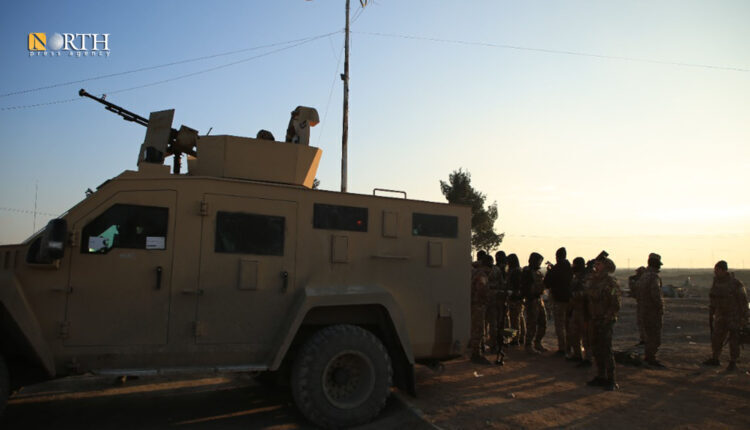
QAMISHLI, Syria (North Press) – As soon as Turkish forces increased their shelling against north and northeast Syria, sleeper cells of the Islamic States (ISIS) were given the impetus to revive again as the Syrian Democratic Forces (SDF) have been preoccupied with the recently initiated Turkish shelling and the threats made of a new ground operation into the region.
Since November 20, Turkish forces have escalated their ground and air bombardment of many areas in northern Syria, severely damaging infrastructures, and causing civilian and military casualties.
A security pocket in charge of Hawl Camp was targeted by the Turkish fighter jets which caused panic in the region over families of ISIS held at the camp.
Although the US-led Global Coalition to Defeat ISIS renewed its commitment to continue the fight against ISIS two months ago the date marking the annual anniversary of the liberation of the city of Raqqa from ISIS with its local partners in Syria, however, the situation remains stagnating following an escalation by the Turkish forces and the threats made to carry out a new military ground operation which made the SDF suspend its operation against the extremist group.
ISIS-related operations suspended
On November 23, the SDF announced it had suspended its operations against sleeper cells of ISIS.
At the time, Director of the Media Center of the SDF Farhad Shami quoted Commander in Chief Mazloum Abdi as saying their forces cannot continue their mission against the group’s cells right now.
Shami cited their forces were preoccupied with the recent Turkish escalation against northeast Syria.
In mid-July Mazloum Abdi said Turkey’s aim of invading the region was to subvert the efforts exerted by the SDF and the Global Coalition against terrorism that could derail the process.
“It is hard for the SDF to battle on two frontlines (against ISIS and Turkey) at the same time,” Abdi said at the time.
ISIS invested in SDF’s preoccupation with the Turkish escalation against the region to launch operations in northeast Syria under the nose of the whole world.
A week after the SDF had suspended its operation, ISIS aired via its affiliated media outlets a footage showing its militants carrying out light and medium weapons nearby a four-wheeled car in Syria.
The footage was said to have been of giving allegiance to the group’s new leader Abu al-Hassan al-Husain al-Qurashi a new successor to the slain one.
Days prior, militants of the group appeared in uniform having explosive belts in rooms on whose walls slogans and photos of the group were hung with individual items of weapons.
The ISIS cells have recently increased their activities in Deir ez-Zor following the announcement that its leader was confirmed killed and naming a new successor late in November.
Since November 20, the group has claimed responsibility for 78 attacks in Deir ez-Zor and Raqqa against SDF in a blatant indication of its attacks making use of the disorder in the region and the attacks carried out by Turkey.
On November 29, the group claimed via its affiliated media outlets an IED explosion in the city of Raqqa in north Syria.
On November 28, ISIS claimed an operation against an SDF military checkpoint in the northern countryside of Deir ez-Zor, east Syria.
The night prior, an IED exploded on the South Cornish close to Souq al-Haal in Raqqa.
On November 22, ISIS claimed it killed an SDF fighter in a town in Deir ez-Zor.
On the very same day, the group claimed two operations against SDF in the countryside of Raqqa and Deir ez-Zor.
It seems that the Turkish shelling of a security pocket in charge of the Hawl Camp has encouraged the group to revive. An attempt by ISIS families to flee the camp was reported.
On November 23, Farhad Shami announced they had captured 6 ISIS family members including three women fleeing the Hawl Camp in the aftermath of the Turkish shelling against the camp’s periphery.
On November 25, security guards at the camp foiled an escaping attempt by a number of ISIS families from the camp.
Days later, the Internal Security Forces of North and East Syria (Asayish) arrested 10 ISIS militants in the countryside of Deir ez-Zor.
On November 30, Justice and Reform Affairs Office of the Autonomous Administration of North and East Syria (AANES) announced alert following reports of a potential attack by ISIS sleeper cells against a jail holding militants in Qamishli.
Although the group was on the rise, Pentagon spokesman Brigadier General Patrick Ryder told reporters that while operations against Islamic State had not stopped, the patrols had to be reduced with the SDF.
Since November 20, the SDF and the Global Coalition to Defeat ISIS mounted four joint patrols on the border inspecting as well gas and oil fields in northeast Syria.
Prior to Turkey’s escalation
Prior to the Turkish recent escalation, there had been no activity by the ISIS cells except for isolated murders that used to take place from time to another. The SDF and the Global Coalition had much time to pursue those cells.
On September 17, the Internal Security Forces of North and East Syria (Asayish) announced the completion of the Humanity and Security Operation to pursue ISIS sleeper cells in Hawl Camp, arresting 226 individuals, including 36 “radical” women, suspected of belonging to ISIS.
“Uniform of the Turkish armed forces and communication devices were found in sweeping operations in the camp,” the statement read.
Women Protection Units (YPJ) in cooperation with the Asayish freed two Yezidi women and four others shackled having traces of torture.
Prior to the Hawl operation, SDF and the Global Coalition carried out joint operations which resulted in the capture of ISIS militants.
In March 2019, the ISIS was territorially ended after the last bastion it held at Baghouz, east of Deir ez-Zor, fell to the SDF and the Global Coalition. However, since that date, the group has survived carrying out operations and murder employing the kick-and-run tactic.
